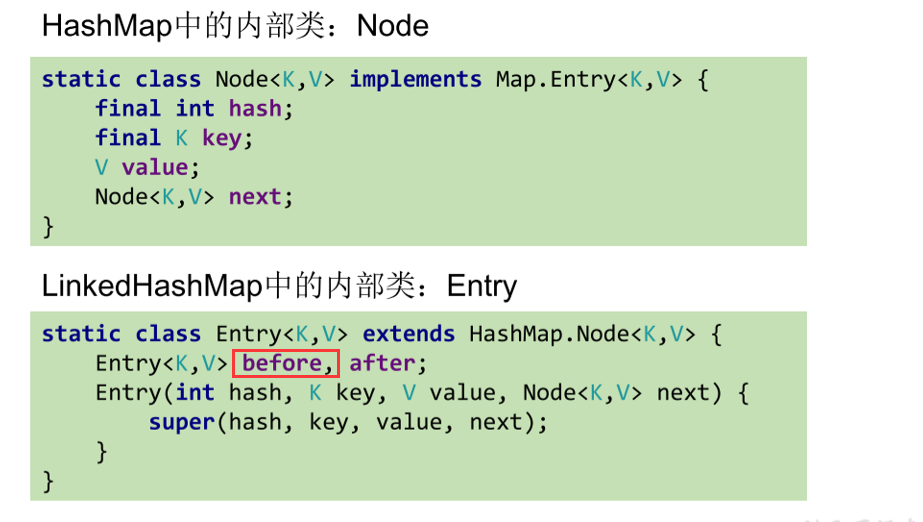LRU
根据题意,使用过的数据放在链表的尾部,容量满了就删除链表的头,使用的数据结构是LinkedHashMap。



146. LRU 缓存(中等)
class LRUCache {
private int cap;
private LinkedHashMap<Integer, Integer> list;
public LRUCache(int capacity) {
this.list = new LinkedHashMap<>();
this.cap = capacity;
}
public int get(int key) {
//cache中不存在,返回-1
if (!list.containsKey(key)) {
return -1;
}
//存在,key变为使用过-放到哈希表末尾
makeRencentlyUsed(key);// 将 key 变为最近使⽤
return list.get(key);
}
/* 添加最近使⽤的元素 */
public void put(int key, int value) {
//存在就更新
if (list.containsKey(key)) {
list.put(key, value);
makeRencentlyUsed(key);//put和get存在的话都要将key提升到最近使用的位置,即链表末尾
return;
}
//判断容量
if (this.cap <= list.size()) {
int oldKey = list.keySet().iterator().next();
list.remove(oldKey);//不满足删除最久没有使用过的数据,即链表头节点
}
list.put(key, value);
}
/* 将某个 key 提升为最近使⽤的 */
private void makeRencentlyUsed(int key) {
int oldValue = list.get(key);
list.remove(key); // 先从链表中删除这个节点
list.put(key, oldValue);// 重新插到队尾
}
}
LFU
460. LFU 缓存(困难)
class LFUCache {
private HashMap<Integer, Integer> keyToValue;
private HashMap<Integer, Integer> keyToFreq;
private HashMap<Integer, LinkedHashSet<Integer>> freqToKey;
private int cap;
private int minFreq;
public LFUCache(int capacity) {
this.keyToValue = new HashMap<>();
this.keyToFreq = new HashMap<>();
this.freqToKey = new HashMap<>();
this.cap = capacity;
this.minFreq = 0;
}
public int get(int key) {
if (!keyToValue.containsKey(key)) {
return -1;
}
increaseFreq(key);// 增加 key 对应的 freq
return keyToValue.get(key);
}
public void put(int key, int value) {
if (this.cap <= 0) return;
/* 若 key 已存在,修改对应的 val 即可 */
if (keyToValue.containsKey(key)) {
keyToValue.put(key, value);
// key 对应的 freq 加一
increaseFreq(key);
return;
}
/* key 不存在,需要插入 */
/* 容量已满的话需要淘汰一个 freq 最小的 key */
if (this.cap <= keyToValue.size()) {
removeMinFreq(key);
}
/* 插入 key 和 val,对应的 freq 为 1 */
// 插入 KV 表
keyToValue.put(key, value);
// 插入 KF 表
keyToFreq.put(key, 1);
// 插入 FK 表
freqToKey.putIfAbsent(1, new LinkedHashSet<>());
// 插入新 key 后最小的 freq 肯定是 1
freqToKey.get(1).add(key);
this.minFreq = 1;
return;
}
private void increaseFreq(int key) {
int oldValue = keyToFreq.get(key);
keyToFreq.put(key, oldValue + 1); /* 更新 KF 表 */
/* 更新 FK 表 */
freqToKey.get(oldValue).remove(key);// 将 key 从 freq 对应的列表中删除
// 如果 freq 对应的列表空了,移除这个 freq
if (freqToKey.get(oldValue).isEmpty()) {
freqToKey.remove(oldValue);
// 如果这个 freq 恰好是 minFreq,更新 minFreq
if (minFreq == oldValue) {
minFreq++;
}
}
freqToKey.putIfAbsent(oldValue + 1, new LinkedHashSet<>());// 将 key 加入 freq + 1 对应的列表中
freqToKey.get(oldValue + 1).add(key);
}
private void removeMinFreq(int key) {
// freq 最小的 key 列表
LinkedHashSet<Integer> list = freqToKey.get(this.minFreq);
// 其中最先被插入的那个 key 就是该被淘汰的 key
Integer oldKey = list.iterator().next();
/* 更新 FK 表 */
list.remove(oldKey);
if (list.isEmpty()) {
freqToKey.remove(this.minFreq);
// 问:这里需要更新 minFreq 的值吗?
}
keyToValue.remove(oldKey); /* 更新 KV 表 */
keyToFreq.remove(oldKey); /* 更新 KF 表 */
}
}
最后
以上就是搞怪篮球最近收集整理的关于LRU和LFULRULFU的全部内容,更多相关LRU和LFULRULFU内容请搜索靠谱客的其他文章。
本图文内容来源于网友提供,作为学习参考使用,或来自网络收集整理,版权属于原作者所有。








发表评论 取消回复